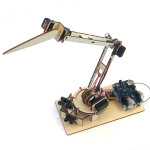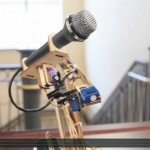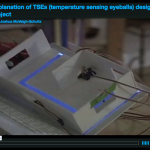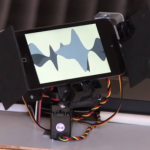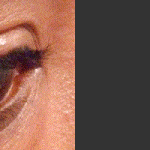At Intel Labs, I worked on a project that positioned data from mobile sensors and web APIs as the raw material for playful experience. I aimed to empower users through simple tools for experimentation, invention, and self-expression. As part of this research, I prototyped an evocative “Data Monster” which looked something like a cross between… Read more »
December 17, 2015
Interning at Intel Labs, I researched and designed new playful ways of engaging with data in everyday life. As part of this project I conducted fieldwork with teens, prototyped “data-sandbox” toolkits, designed and led playtests with target demographics, interviewed luminaries in the field of play, and synthesized findings with emerging opportunities in the fields of IoT and quantified-self. Outside participants included… Read more »
December 16, 2015
Baby’s First Touch Screen is a design fiction short I made about a touch screen that doesn’t want to be touched. If a user attempts to touch the device too quickly, two shielding appendages close. In this short scenario, an expectant mother is devastated when her newly purchased “Baby’s First Touch Screen” device is stolen by a… Read more »
December 15, 2015
The AudienceBot Microphone is an interactive platform that enables audiences to convey feedback to performers in real-time. Using a mobile application audience participants collectively determine the “mood” of the microphone. The microphone utilizes six servo motors and a motion tracking device to express a range of affective states, from inattentive to attentive and from playful… Read more »
November 3, 2014
(2010) Collaboration with Michael Annetta. This design uses XML data from NAVTEQ to translate daily traffic flow at particular road sections into a rhythmic pulses that maps onto PWM voltage for vibrating motors. By the year 2060, all the humans who survived peak-oil live in giant honeycomb-like structures that contain self-sustaining mini-ecologies within each geodesic… Read more »
February 8, 2012
This design emerged from thinking about how social surveillance operates to regulate recycling practice in Japan. I wanted to come up with a design that leveraged this kind of imagination about the gaze of others — but instead of being surveilled by one’s cohabitants, one would be surveilled by tiny eyes that run along the floor. These eyes would be “cute” much the way that public service posters in Japan leverage the cuteness of mascots to encourage you to remember important instructions. Instead of focusing on recycling practice, though, I wanted these eyes to be regulating hot or cold air leakage (by guiding an inhabitant to close an open window for example).
Designed as a critique of status monitoring in online contexts, this project presents a prototype of a prosthetic device that conversation partners wear in their mouths to provide visual and auditory feedback about the speaker’s level of online popularity (measured in retweets). The speaker with more current retweets experiences voice amplification (and their mouth glows… Read more »
Completed for Phil van Allen’s New Ecologies of Things course at the Art Center, this project presents prospective interactants with a touch interface that doesn’t “want” to be touched. When touch screen interface devices are found in the wild, their shielding appendages haven’t been clipped yet. As you might expect, these appendages have to be… Read more »
February 7, 2012
I’m interested in interactive systems that get completed by leaps of imagination or by social mediation. One example I’ve pointed to is the elevator close-door button. This is a device that is often non-functional yet nevertheless encourages us to assign causality even where there is none. Building on this the idea, I created a responsive… Read more »
